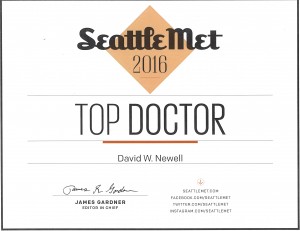Seattle Neuroscience Institute
- Home
- Conditions & Treatments
- Arteriovenous Malformation AVM
- Brain Aneurysm | Cerebral Aneurysm
- Carotid Artery Disease
- Cavernous Malformations
- Colloid Cyst
- Glossopharyngeal Neuralgia
- Hemifacial Spasm
- Meningioma
- Minimally Invasive Spine Surgery
- Moyamoya Disease
- Spinal Canal and Spinal Cord Tumors
- Transient Vertebrobasilar Insufficiency
- Trigeminal Neuralgia Treatment
- Research & Publications
- Practice Locations
- About
- Contact
Press
Seattle Magazine 2016: Top Doctors – Neurosurgery
These surgeons specialize in diagnosis and treatment of disorders of the nervous system.
Richard G. Ellenbogen, M.D., Chiari’s deformity, brain tumors, minimally invasive surgery; Seattle Children’s Hospital, 4800 Sand Point Way NE, Seattle, 206.987.2544; Seattle Children’s, Harborview Medical Center; Brown University, Warren Alpert Medical School, 1983
Marc R. Mayberg, M.D., pituitary surgery, skull base tumors, acoustic neuroma; Swedish Neuroscience Institute, 550 17th Ave., Suite 540, Seattle, 206.320.2992; Swedish Medical Center–Cherry Hill; Mayo Medical School, 1978
David W. Newell, M.D., cerebral aneurysms, arteriovenous malformations, cavernous malformations; Swedish Neuroscience Institute, 550 17th Ave., Suite 110, Seattle, 206.320.3470; Swedish Medical Center–Cherry Hill; Case Western Reserve University, 1982
Jeffrey G. Ojemann, M.D., brain tumors, craniosynostosis, hydrocephalus; Seattle Children’s Hospital, 4800 Sand Point Way NE, Seattle, 206.987.2544; Seattle Children’s, UW Medical Center; Washington University, St. Louis, 1992
Laligam N. Sekhar, M.D., cerebral aneurysm, arteriovenous malformations, brain and skull base tumors; UW Medicine, Neurosurgery, 908 Jefferson St., Seattle, 206.744.1876; Harborview Medical Center, UW Medical Center; Madras Medical College, India, 1973
Daniel L. Silbergeld, M.D., brain tumors, brain mapping, neuro-oncology; UW Medicine, Neurosurgery, 1959 NE Pacific St., Seattle, 206.598.5637; UW Medical Center, Harborview Medical Center, Seattle Cancer Care Alliance; University of Cincinnati, 1984
Groundbreaking Study Using Ultrasound for the Treatment of Intracerebral and Intraventricular Hemorrhage Stroke Shows Promise
SEATTLE, Feb. 25 /PRNewswire-USNewswire/ — David Newell, M.D., co-executive director of the Swedish Neuroscience Institute (SNI) in Seattle today presented results of a groundbreaking study of 33 patients with spontaneous intracerebral hemorrhage who were screened for inclusion in a SNI clinical study known as ‘SLEUTH’ (Safety of Lysis with Ultrasound in the Treatment of Intracerebral and Intraventricular Hemorrhage). The presentation took place at the American Heart Association’s International Stroke Conference in San Antonio, Texas. Co-authors of the study include Mohsin Shah, M.D., (SNI); Daniel F. Hanley, M.D., Johns Hopkins University Medical School (Baltimore, MD); Douglas Hansmann, Ph.D., and Robert Wilcox (Bothell, WA).
Treatment was conducted in the operating room and included placement of a burr hole, as well as navigation of the ultrasound and drainage catheter into the hemorrhage using a GPS-like system (STEALTH) for optimal catheter placement. Ultrasound was then delivered to the hemorrhage, in addition to the thrombolytic (strong blood thinner) drug tissue plasminogen activator (rt-PA) for 24 hours.
A Brain Surgery Revolution: Using Sound Instead of Scalpels
SEATTLE, Nov 1, 2015. Doctors can now operate deep within the brain using focused ultrasound, ushering in a new era of faster, safer incision-free procedures
Carol Aldrich first noticed a slight tremor in her right hand when she was in her early 50s. Working for an optometrist in Port Townsend, Wash., a picturesque town on the Olympic Peninsula, Aldrich routinely performed delicate work with her fingers—replacing broken eyeglass lenses and repairing frames. At least initially, her tremor would come and go, leaving her sometimes unable to manage tiny screws and fragile settings. “I just thought I had had too much coffee,” the mother of three recalls.
Ekos’ Ultrasound Shown to Treat Brain Hemorrhage
SEATTLE, Feb 25, 2010 — Ekos Corporation (Bothell, WA) announced that David W. Newell, MD, presented findings from the SLEUTH (Safety of Lysis With Ultrasound in the Treatment of Intracerebral [ICH] and Intraventricular Hemorrhage [IVH]) study at the International Stroke Conference 2010 in San Antonio, Texas. Dr. Newell is Co- Executive Director of the Swedish Neuroscience Institute in Seattle, Washington, which conducted SLEUTH. Ekos noted that ICH is a devastating form of stroke in which half of all patients die within 1 month of the event, and those who survive typically experience dramatic loss of brain function and motor skills.
According to Dr. Newell, the objective of SLEUTH was to evaluate the safety and efficacy of a novel therapy that combines ultrasound with recombinant tissue plasminogen activator (rt-PA) delivered through a microcatheter directly into spontaneous IVH or ICH patients, to facilitate evacuation of the hemorrhage. Thirty-five patients presented at the Swedish Neuroscience Institute with ICH and IVH and were screened between November 2008 and July 2009 for entry into the study. Entry criteria included the spontaneous onset of ICH ≥ 25 mL and or IVH producing ventricular obstruction. Nine patients (aged 38–83 years, average = 63; 6 men, 3 women) who met entry criteria were consented and entered into the trial. A ventricular drainage catheter and an ultrasound microcatheter were stereotactically delivered together directly into the IVH or ICH. The patients were treated with rt-PA and 24 hours of continuous ultrasound, and gravity drainage was performed. In patients with IVH, a total of 3 mg of rt-PA was injected, and in patients with intraparenchymal hemorrhages, a total of 0.9 mg of rt-PA was injected in three doses over 24 hours.
Arteriovenous Malformation Awareness
If you’re healthy but suddenly start getting migraine-type headaches, trip or fall… Pay attention, it could be your brain telling you something is wrong.
57-year old linda christianson is fine now, but two years ago when she tripped on the stairs and then stumbled while walking, her family knew something was wrong. Linda christianson says, “the two incidents happened within a week of each other and then i saw the physician about eight days after that.”
An m-r-i showed a problem in the front section of linda’s brain. She had a cluster of abnormally formed blood vessels and was diagnosed with a-v-m. Doctor david w. Newell says, “i describe it to patients or interested individuals as a tangle of blood vessels in the brain. It kind of looks like a nest of snakes that you would see in some of the old medieval drawings.” doctor david newell treats 30 to 40 a-v-m patients a year.
When veins are tangled, they can rupture and cause bleeding in the brain. Removal through surgery is one option. Doctor david w. Newell says, “once the avm is successfully treated and safely removed and patients do well, they should expect to have a normal lifespan.” linda’s a-v-m was in the front, “silent” area of her brain… Away from critical structures that affect speech or sensory and motor function.
David w. Newell says, “avm’s really form in all different locations of the brain, they’re probably a little bit more common in the frontal regions, but they can form in any part of the brain.” linda christianson says, “i don’t think a lot of patients are as lucky as i’ve been. I mean, i had an early diagnosis, i had a phenomenal surgeon. They took care of it and my recovery’s been terrific.” linda is active again… Biking, hiking, and skiing with her family.








